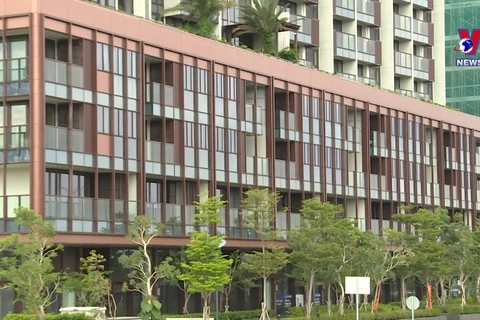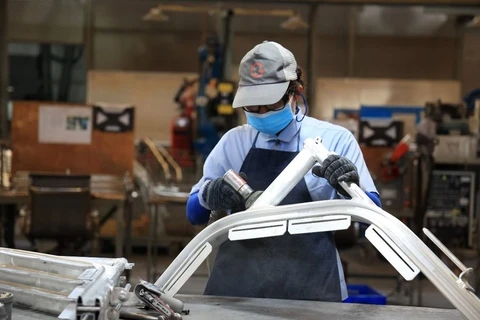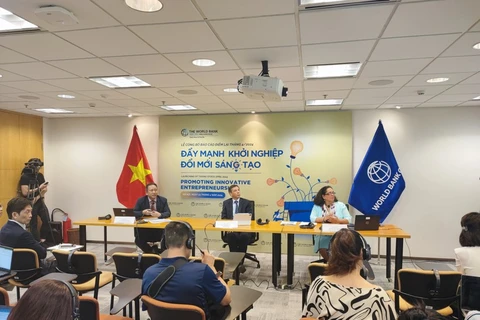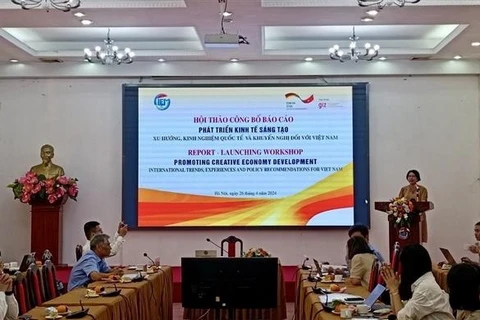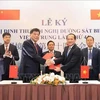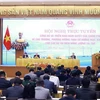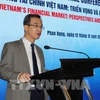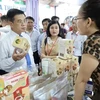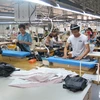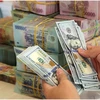Hanoi (VNA) – Since the national reunification on April 30, 1975, Vietnam has obtained admirable economic achievements and is now on its way to become the 20th largest economy in the world.
Back to 1975, Vietnam, torn by two major wars, was a backward economy dependent on agriculture and foreign assistance. Foreign loans and aid accounted for over 63% of its budget.
During 1976 - 1980, the gross domestic product (GDP) grew by just 1.4% and even contracted 1% in 1980, when the country imported up to 1.57 million tonnes of food.
The implementation of the five-year economic plan 1976 - 1980 encountered difficulties. Meanwhile, assistance from other socialist countries fell sharply, and China completely ceased support for Vietnam from 1977.
The wars along the southern and northern borders in 1979 added a further complication as they led to a dramatic increase in defence expenses amid suspended assistance from external sources.
Facing that fact, the Party and State initiated some changes to economic policies in 1979. In September that year, the 4th Party Central Committee held its 6th session, during which it released Resolution No. 20-NQ/TW, which allowed combining the planning mechanism with the market one and reusing the private economy, including private capital, under the State’s management. This was considered the first breakthrough in terms of mindset and economic viewpoint.
At its 9th session held in December 1980, the 4th Party Central Committee decided to expand and complete piecework in agriculture. On January 13, 1981, the Party Central Committee’s Secretariat issued Directive 100-CT/TW on improving the use of piecework and expanding this form of work to labourers and groups of labourers in agricultural cooperatives. This directive, also called Piecework 100, permitted the application of piecework to the entire agriculture nationwide
From 1981, the Vietnamese economy began flourishing, with food production surging, industrial production value growing relatively well, and trade deficit reducing considerably.
However, in late 1985 and 1986, the plan on price - salary - money reforms failed to achieve the desired results due to the patchy combination of reforms and old models, leading to serious consequences. This crisis made the Party and State realise that reforms must be carried out thoroughly.
In December 1986, the 6th National Party Congress issued a historic reform policy – switching from a centrally planned economy with subsidies to a multi-component commodity economy that operates in line with the market mechanism and is managed by the State and oriented towards socialism.
 Workers at a factory of the Japanese-invested Sankoh Vietnam Co. Ltd in Hoa Binh province (Photo: VNA) As a result, GDP expanded by an annual average of 6.51% during 1986 - 2000. Economic structure was shifted towards enhanced industralisation and modernisation.
Workers at a factory of the Japanese-invested Sankoh Vietnam Co. Ltd in Hoa Binh province (Photo: VNA) As a result, GDP expanded by an annual average of 6.51% during 1986 - 2000. Economic structure was shifted towards enhanced industralisation and modernisation.
Since 2001, Vietnam has recorded strong economic development and integration into the world. The GDP in 2009 increased 12.5-fold from 2001 while the annual GDP growth rate during 2001 - 2010 stood at 7.26%.
Since 2008, it emerged from a low-income country to a lower-middle-income one. Per capita GDP reached 2,715 USD in 2019, soaring 15-fold from 1990. The poverty rate, as calculated by the World Bank, dropped to 6.7% in 2018 from 28.9% in 2002.
In 2019, Vietnam ranked eighth worldwide and second in ASEAN in terms of GDP growth. It was one of the 30 countries with the fastest foreign trade expansion and also established itself as the 22nd largest exporting country around the globe.
Data released by the General Statistics Office in 2023 showed that GDP, as calculated at current prices, topped 10.221 quadrillion VND (430 billion USD). With this result, the size of the Vietnamese economy stood at the 34th place on last year’s rankings by the UK-based Centre for Economics and Business Research (CEBR).
The International Monetary Fund (IMF) noted that in 2023, Vietnam ranked third in Southeast Asia with its GDP based on purchasing power parity (PPP) estimated at 1.438 trillion USD, following Indonesia (4.391 trillion USD) and Thailand (1.563 trillion USD), and 25th in the world.
By 2026, its GDP (PPP) is predicted to hit some 1.833 trillion USD to rank second in Southeast Asia, after Indonesia. The figure is forecast to reach 2.343 trillion USD to secure the 20th position globally for the economy by 2029./.
Back to 1975, Vietnam, torn by two major wars, was a backward economy dependent on agriculture and foreign assistance. Foreign loans and aid accounted for over 63% of its budget.
During 1976 - 1980, the gross domestic product (GDP) grew by just 1.4% and even contracted 1% in 1980, when the country imported up to 1.57 million tonnes of food.
The implementation of the five-year economic plan 1976 - 1980 encountered difficulties. Meanwhile, assistance from other socialist countries fell sharply, and China completely ceased support for Vietnam from 1977.
The wars along the southern and northern borders in 1979 added a further complication as they led to a dramatic increase in defence expenses amid suspended assistance from external sources.
Facing that fact, the Party and State initiated some changes to economic policies in 1979. In September that year, the 4th Party Central Committee held its 6th session, during which it released Resolution No. 20-NQ/TW, which allowed combining the planning mechanism with the market one and reusing the private economy, including private capital, under the State’s management. This was considered the first breakthrough in terms of mindset and economic viewpoint.
At its 9th session held in December 1980, the 4th Party Central Committee decided to expand and complete piecework in agriculture. On January 13, 1981, the Party Central Committee’s Secretariat issued Directive 100-CT/TW on improving the use of piecework and expanding this form of work to labourers and groups of labourers in agricultural cooperatives. This directive, also called Piecework 100, permitted the application of piecework to the entire agriculture nationwide
From 1981, the Vietnamese economy began flourishing, with food production surging, industrial production value growing relatively well, and trade deficit reducing considerably.
However, in late 1985 and 1986, the plan on price - salary - money reforms failed to achieve the desired results due to the patchy combination of reforms and old models, leading to serious consequences. This crisis made the Party and State realise that reforms must be carried out thoroughly.
In December 1986, the 6th National Party Congress issued a historic reform policy – switching from a centrally planned economy with subsidies to a multi-component commodity economy that operates in line with the market mechanism and is managed by the State and oriented towards socialism.
 Workers at a factory of the Japanese-invested Sankoh Vietnam Co. Ltd in Hoa Binh province (Photo: VNA)
Workers at a factory of the Japanese-invested Sankoh Vietnam Co. Ltd in Hoa Binh province (Photo: VNA) Since 2001, Vietnam has recorded strong economic development and integration into the world. The GDP in 2009 increased 12.5-fold from 2001 while the annual GDP growth rate during 2001 - 2010 stood at 7.26%.
Since 2008, it emerged from a low-income country to a lower-middle-income one. Per capita GDP reached 2,715 USD in 2019, soaring 15-fold from 1990. The poverty rate, as calculated by the World Bank, dropped to 6.7% in 2018 from 28.9% in 2002.
In 2019, Vietnam ranked eighth worldwide and second in ASEAN in terms of GDP growth. It was one of the 30 countries with the fastest foreign trade expansion and also established itself as the 22nd largest exporting country around the globe.
Data released by the General Statistics Office in 2023 showed that GDP, as calculated at current prices, topped 10.221 quadrillion VND (430 billion USD). With this result, the size of the Vietnamese economy stood at the 34th place on last year’s rankings by the UK-based Centre for Economics and Business Research (CEBR).
The International Monetary Fund (IMF) noted that in 2023, Vietnam ranked third in Southeast Asia with its GDP based on purchasing power parity (PPP) estimated at 1.438 trillion USD, following Indonesia (4.391 trillion USD) and Thailand (1.563 trillion USD), and 25th in the world.
By 2026, its GDP (PPP) is predicted to hit some 1.833 trillion USD to rank second in Southeast Asia, after Indonesia. The figure is forecast to reach 2.343 trillion USD to secure the 20th position globally for the economy by 2029./.
VNA


